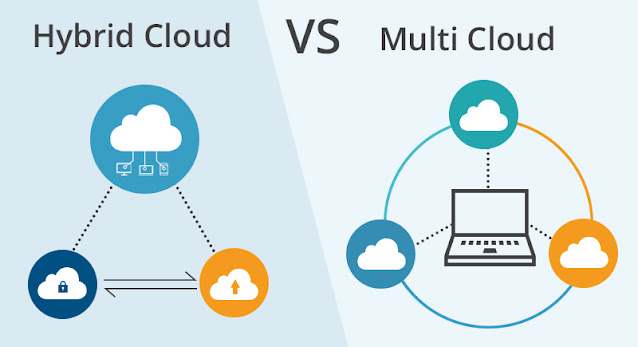
In today’s world, cloud computing has become an integral part of businesses of all sizes. With the growing demand for cloud-based solutions, organizations are now exploring different types of cloud deployments. Among them, multi and hybrid cloud deployments have gained significant attention due to their flexibility and scalability.
Multi and hybrid cloud deployment refer to the use of multiple cloud services from different cloud providers to meet the diverse requirements of an organization. In this article, we will explore the concept of multi and hybrid cloud deployment in detail.
What is Multi and Hybrid Cloud Deployment?
Multi and hybrid cloud deployment refer to the use of multiple cloud services from different cloud providers to meet the diverse requirements of an organization. Multi-cloud deployment involves using two or more cloud services from different cloud providers, while hybrid cloud deployment combines on-premises infrastructure with cloud services.
In multi-cloud deployment, an organization can use different cloud providers for different workloads based on their specific requirements. For example, an organization can use AWS for hosting its website and use Azure for running its database. This approach allows organizations to take advantage of the strengths of different cloud providers.
In hybrid cloud deployment, an organization can use a combination of on-premises infrastructure and cloud services. This approach is beneficial for organizations that have sensitive data or workloads that require low latency.
Benefits of Multi and Hybrid Cloud Deployment
Flexibility and Scalability
Multi and hybrid cloud deployment offers organizations the flexibility to choose the cloud services that best meet their requirements. It also allows organizations to scale their resources based on their needs, ensuring optimal resource utilization.
Cost-Effective
Multi and hybrid cloud deployment can be cost-effective as it allows organizations to choose the most cost-efficient cloud services for their workloads. It also eliminates the need for organizations to invest in expensive hardware or software.
Improved Performance and Availability
By using multiple cloud services, organizations can improve the performance and availability of their applications. For example, an organization can use a CDN service to improve the performance of its website and use a load balancing service to ensure high availability.
Better Disaster Recovery
Multi and hybrid cloud deployment can provide better disaster recovery options. By using multiple cloud providers, organizations can ensure that their applications are not affected by a single point of failure. In case of a disaster, organizations can quickly recover their data and applications from another cloud provider.
Challenges of Multi and Hybrid Cloud Deployment
Integration Complexity
One of the biggest challenges of multi and hybrid cloud deployment is the complexity of integrating different cloud services. Each cloud provider has its own APIs, tools, and interfaces, which can make it challenging to integrate them seamlessly. Without proper integration, it can be difficult to get a holistic view of the entire infrastructure, leading to operational inefficiencies.
To overcome this challenge, organizations should invest in integration platforms that can help to simplify and automate the integration process. These platforms can provide a unified view of the entire infrastructure, allowing organizations to manage and monitor their cloud deployments effectively.
Data Security
Another challenge of multi and hybrid cloud deployment is data security. With data being spread across different cloud environments, it can be challenging to ensure that it is secure and compliant with industry regulations. Additionally, different cloud providers have different security protocols, making it difficult to maintain a consistent level of security across the infrastructure.
To address this challenge, organizations should adopt a comprehensive security strategy that includes encryption, access controls, and regular audits. They should also ensure that all cloud providers they work with adhere to industry standards and regulations.
Vendor Lock-In
Vendor lock-in is another challenge of multi and hybrid cloud deployment. When organizations use multiple cloud providers, they may find themselves locked into specific technologies or services, making it difficult to switch providers or migrate data.
To avoid vendor lock-in, organizations should choose cloud providers that offer open standards and provide options for migrating data and applications to other providers. They should also ensure that they have a clear exit strategy in place in case they need to switch providers.
Performance Management
Managing performance across multiple cloud providers can be challenging, particularly when it comes to ensuring consistent application performance. With different cloud providers having different service level agreements (SLAs) and performance metrics, it can be challenging to maintain a consistent level of performance across the entire infrastructure.
To overcome this challenge, organizations should implement performance monitoring tools that provide real-time visibility into the entire infrastructure. These tools can help organizations identify and resolve performance issues quickly, ensuring that they meet their SLAs.
Cost Management
Finally, cost management is another challenge of multi and hybrid cloud deployment. With different cloud providers charging different rates for their services, it can be challenging to manage costs effectively. Additionally, it can be difficult to predict costs accurately, particularly when it comes to variable costs such as storage and data transfer.
To manage costs effectively, organizations should adopt a cost optimization strategy that includes regular monitoring and optimization of cloud usage. They should also choose cloud providers that offer transparent pricing models and provide tools for monitoring and managing costs.
Best Practices for Multi and Hybrid Cloud Deployment
Plan your Cloud Strategy
Organizations should have a clear cloud strategy that outlines their requirements, goals, and priorities. This will help them choose the right cloud services and providers.
Choose the Right Cloud Providers
Organizations should choose cloud providers that best meet their requirements in terms of performance, security, compliance, and cost.
Ensure Cloud Integration
Organizations should ensure that their cloud services are integrated seamlessly to ensure optimal performance and availability.
Prioritize Security and Compliance
Organizations should prioritize security and compliance across all the cloud services they use. This includes implementing security measures and ensuring compliance with regulations.
Optimize Cloud Performance
Organizations should optimize their cloud performance by using automation and orchestration tools. This can help them manage multiple cloud services more efficiently.
Use Cases of Multi and Hybrid Cloud Deployment
- E-Commerce: Multi and hybrid cloud deployment can be beneficial for e-commerce businesses that require high availability and scalability.
- Healthcare: Multi and hybrid cloud deployment can be beneficial for healthcare organizations that require secure and compliant storage and processing of sensitive data.
- Banking and Finance: Multi and hybrid cloud deployment can be beneficial for banking and finance organizations that require high-performance computing and secure data storage.
- Gaming: Multi and hybrid cloud deployment can be beneficial for gaming companies that require high availability and low latency.
- IoT and Smart Cities: Multi and hybrid cloud deployment can be beneficial for IoT and smart city applications that require real-time data processing and analysis.
FAQ about Multi and Hybrid Cloud Deployment
Q What is the difference between multi and hybrid cloud deployment?
Multi-cloud deployment refers to the use of multiple cloud services from different providers to meet specific requirements. Hybrid cloud deployment refers to the use of multiple cloud services from different providers that are integrated with each other.
Q How to ensure security in multi and hybrid cloud deployment?
To ensure security in multi and hybrid cloud deployment, organizations should implement security measures such as access control, encryption, and monitoring. They should also ensure compliance with regulations across all the cloud services they use.
Q Can multi and hybrid cloud deployment lead to vendor lock-in?
Yes, multi and hybrid cloud deployment can lead to vendor lock-in if organizations rely too heavily on a single cloud provider. To avoid vendor lock-in, organizations should choose cloud providers that best meet their requirements and prioritize cloud interoperability.
Q How to optimize performance in multi and hybrid cloud deployment?
To optimize performance in multi and hybrid cloud deployment, organizations should use automation and orchestration tools to manage multiple cloud services more efficiently. They should also ensure that their cloud services are integrated seamlessly and prioritize cloud performance monitoring and optimization.
Conclusion
Multi and hybrid cloud deployment offer organizations the flexibility, scalability, and cost-effectiveness to meet their diverse requirements. However, they also pose security, compliance, complexity, and interoperability challenges.
By following best practices and choosing the right cloud providers, organizations can take advantage of the benefits of multi and hybrid cloud deployment while minimizing its challenges.




